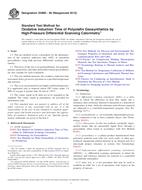Potrebujeme váš súhlas na využitie jednotlivých dát, aby sa vám okrem iného mohli ukazovať informácie týkajúce sa vašich záujmov. Súhlas udelíte kliknutím na tlačidlo „OK“.
ASTM D5885-06(2012)
Standard Test Method for Oxidative Induction Time of Polyolefin Geosynthetics by High-Pressure Differential Scanning Calorimetry
Automaticky preložený názov:
Štandardná skúšobná metóda pre oxidačné Indukčný doba polyolefínov Geosynthetics vysokotlakovým diferenčný skenovací kalorimetria
NORMA vydaná dňa 1.7.2012
Informácie o norme:
Označenie normy: ASTM D5885-06(2012)
Poznámka: NEPLATNÁ
Dátum vydania normy: 1.7.2012
Kód tovaru: NS-32944
Počet strán: 5
Približná hmotnosť: 15 g (0.03 libier)
Krajina: Americká technická norma
Kategória: Technické normy ASTM
Anotácia textu normy ASTM D5885-06(2012) :
Keywords:
differential scanning calorimetry, geogrid, geomembrane, geonets, geopipes, geosynthetics, geotextiles, oxidation, polyethylene, polyolefins, polypropylene, ICS Number Code 59.080.70 (Geotextiles)
Doplňujúce informácie
| Significance and Use | ||||||||||||||||||
|
5.1 The oxidative induction time is a characteristic of a compounded polyolefin product that is dependent not only on the type and amount of additives present, but also on the type of resin. In well-behaved systems, this test method can be used as a quality control measure to monitor the stabilization in geosynthetics as received from a supplier. 5.2 When this test method is used to compare different geomembrane formulations containing different antioxidant packages, then those results shall be considered valid only at the temperature of test. 5.3 This test method is intended as an geosynthetic test. Use of the OIT value to estimate the lifetime of the geomembrane from which the test specimen is taken is not addressed nor shall it be used for this purpose. 5.3.1 The OIT measurement is an accelerated thermal aging test and, as such, interpretation of resulting data may be misleading if done by an inexperienced operator. Caution should be exercised in data interpretation since oxidation reaction kinetics are a function of temperature and the properties of the additives contained in the geosynthetic sample. For example, OIT values are often used to select optimum resin formulations. Certain antioxidants, however, may generate poor OIT results even though they may be adequate at their intended use temperature and vice versa. 5.4 This test method can be used for other purposes such as manufacturing control and research and development. 5.5 Oxidation induction time is strongly dependent upon test temperature and the partial pressure of oxygen. The higher the test temperature or the oxygen partial pressure, or both, the shorter the oxidation induction time. 5.5.1 The use of high test temperature, however, may have deleterious effects. The first of these is the potential volatilization of additive packages used to stabilize the test materials. The second is the potential for the influence of chemical mechanisms which are not significant at end-use operation conditions. 5.5.2 This test method uses high oxygen pressure to accelerate the test period while making use of lower test temperatures to protect additive packages. 5.6 The results from this test method may or may not correlate with those obtained by other OIT measurements such as Test Method D3895 or Test Methods D4565. |
||||||||||||||||||
| 1. Scope | ||||||||||||||||||
|
1.1 This test method covers a procedure for the determination of the oxidative induction time (OIT) of polyolefin geosynthetics using high pressure differential scanning calorimetry. 1.2 The focus of the test is on geomembranes, but geogrids, geonets, geotextiles, and other polyolefin-related geosynthetics are also suitable for such evaluation. 1.3 This test method measures the oxidative induction time associated with a given test specimen at a specified temperature and pressure. 1.4 This is an accelerated test for highly stabilized materials. It is applicable only to material whose OIT values under 3.4 MPa of oxygen is greater than 30 min at 150°C. 1.5 The values stated in SI units are to be regarded as the standard. The values stated in parentheses are provided for information only. 1.6 This standard does not
purport to address all of the safety concerns, if any, associated
with its use. It is the responsibility of the user of this standard
to establish appropriate safety and health practices and determine
the applicability of regulatory limitations prior to use.
Standard Test Methods for Water
Permeability of Geotextiles by Permittivity Standard Test Methods for Physical and
Environmental Performance Properties of Insulations and Jackets for
Telecommunications Wire and Cable Standard Practice for Compression Molding
Thermoplastic Materials into Test Specimens, Plaques, or Sheets Standard Terminology Relating to Thermal
Analysis and Rheology (Includes all amendments and changes
10/5/2023). Standard Test Method for Temperature
Calibration of Differential Scanning Calorimeters and Differential
Thermal Analyzers Standard Practice for Conducting an
Interlaboratory Study to Determine the Precision of a Test
Method Standard Guide for Designing Systems for
Oxygen Service Standard Test Method for
Oxidative-Induction Time of Polyolefins by Differential Scanning
Calorimetry Standard Terminology for
Geosynthetics |
Odporúčame:
Aktualizácia zákonov
Chcete mať istotu o platnosti využívaných predpisov?
Ponúkame Vám riešenie, aby ste mohli používať stále platné (aktuálne) legislatívne predpisy
Chcete vedieť viac informácií ? Pozrite sa na túto stránku.




 Cookies
Cookies
